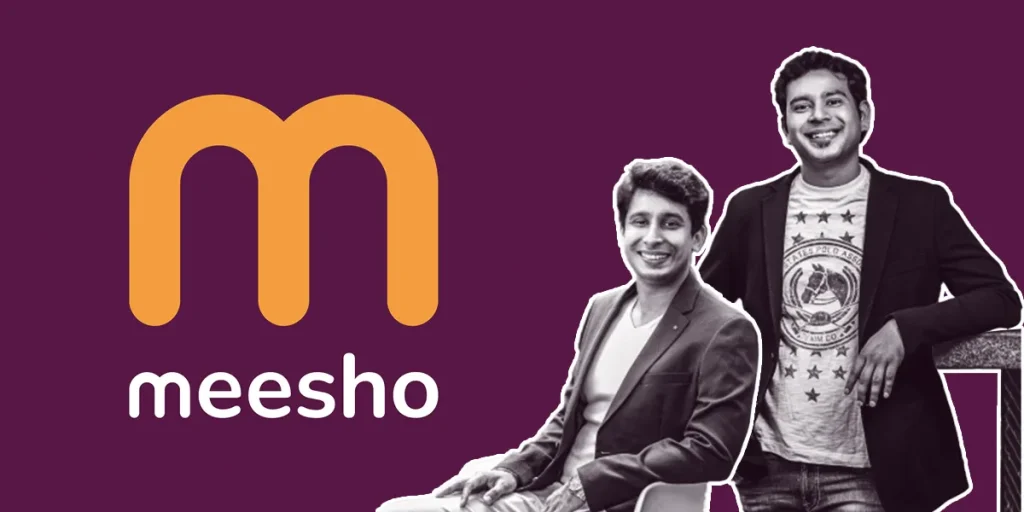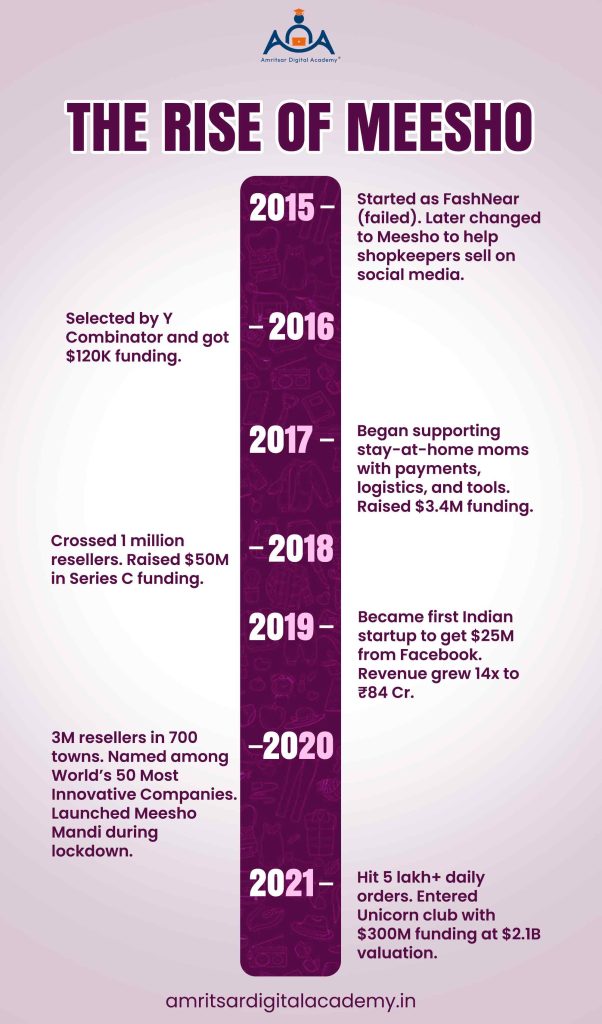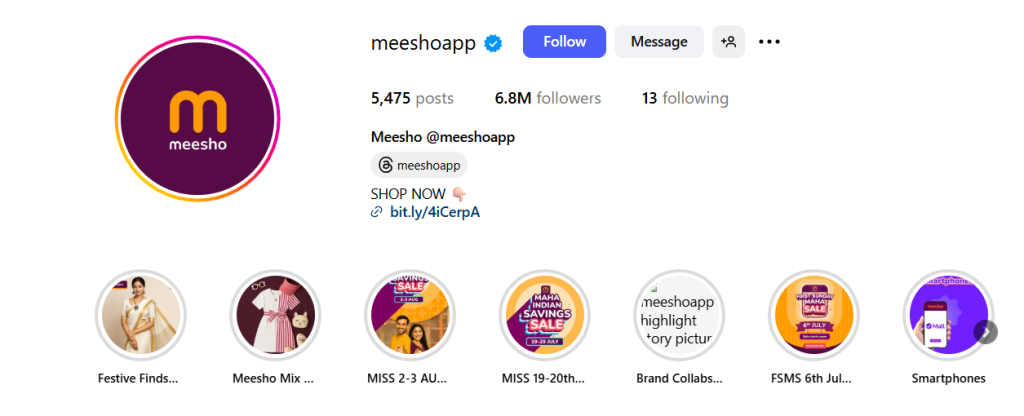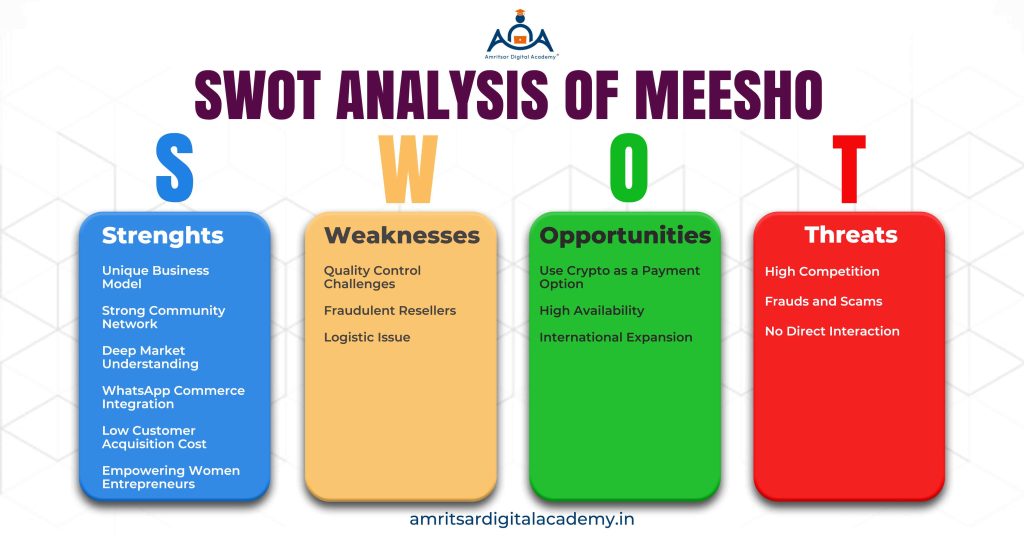Standing out in the e-commerce market alongside big giants like Amazon and Flipkart with different strategies is quite commendable. Messho is one startup that quietly built something extraordinary by focusing on social commerce. The Meesho case study proves that every startup has its fair share of success and shortcomings but despite all the obstacles it comes out on top.
Meesho focuses on power of social commerce and WhatsApp to reach millions of small entrepreneurs across India’s smaller towns and cities. Meesho’s journey offers valuable lessons about understanding your market, innovative marketing tactics, and sustainable business growth. In this Meesho case study, we talked about its startup journey, Meesho business model, revenue generation, marketing strategies, and the challenges it faced on the road to success.
Table of Contents
- Meesho Startup Journey
- Meesho Business Model and How Does Meesho Work?
- Meesho Revenue Model – How Does Meesho Make Money?
- Meesho Marketing Strategy That Fueled Its Growth
- Challenges Faced by Meesho in Its Journey
- SWOT Analysis of Meesho
- Key Lessons from Meesho Case Study for Entrepreneurs & Marketers
- Final Words

Meesho Startup Journey
Two IITs, Vidit Aatrey and Sanjeev Barnwal who are the founders of Meesho, found massive gap in India’s ecommerce ecosystem. They realise there are many small shop owners and individuals lacking physical stores in promoting their products online. That’s how Meesho was started in December 2015. The name ‘Meesho’ is derived from ‘Meri Shop’ which gave opportunities to small scale businesses to promote and sell their products online without physical shop.
In starting stage, company struggled a lot because reselling was not main goal. But things changed when the founders noticed how people in India used WhatsApp groups for buying and selling items. They tapped into this habit and allowed sellers to share product catalogs directly with their network. This became the foundation of WhatsApp commerce and the turning point in Meesho’s growth.
Meesho was the first Indian startup who receive investment from Facebook to expand their social commerce in 2019. Now Meesho competes with large e-commerce platforms like Amazon, Flipkart and even Shopsy but what makes Meesho unique is its focus on affordability and Tier-2, Tier-3 audiences.

Meesho Business Model and How Does Meesho Work?
Meesho follows reselling business model. The Meesho ecosystem works through simple yet effective flow: Supplier → Meesho Platform → Reseller → End Customer. Here is how each step works:
Supplier: They list their product on Meesho platform with wholesale prices.
Resellers: They search through thousands of products and select products that they want to sell on their social media platforms or WhatsApp groups by adding profit margin to the wholesale prices.
Customers: Customers buy products from their trusted resellers in their network at affordable prices.

Order fulfillment happens through Meesho’s logistics network, ensuring quality control and timely delivery while the reseller earns their profit margin. The best part of Meesho business model is that it requires minimal investment from resellers – no inventory, no warehousing, no shipping hassles. They simply need to identify customer needs and connect them with suitable products.
Meesho Uses WhatsApp Commerce as Growth Engine
Meesho strategically plays smart moves by using WhatsApp commerce. Most Indians use WhatsApp on their smartphones so that resellers can easily share catalogs with family, friends, and groups with just simple conversation driven commerce. This approach is particularly effective in India where social proof and personal recommendations strongly influence purchase decisions.
Meesho Revenue Model – How Does Meesho Make Money?
You have a question in your mind! If Meesho operates on zero commission then how does Meesho make money?
Here is the answer to your question– Meesho generates revenue through seller advertisements and other methods mentioned below:
1. Commissions from Suppliers
Initially Meesho charged small amount of commission from suppliers on every sale but later they reduced it to zero to attract more sellers and earn revenue from other sources.
2. Logistics and Fulfillment Fees
Meesho provides in house logistics to sellers and generates revenue from delivery charges, for warehousing, packaging, and last mile delivery services.
3. Advertisement Revenue
Suppliers can pay for premium placement, featured listings, and promotional campaigns on the platform. This revenue stream is growing as competition among suppliers increases.
4. Payment Processing Fees
Small fees from payment gateway services, though this contributes minimally to overall revenue.
According to news reports Meesho’s GMV crossed $4.5 billion in FY23 which shows how strong the platform has become.
Meesho Marketing Strategy That Fueled Its Growth
When we talked about Meesho’s growth journey, their success largely comes from digital marketing strategies. Meesho built its growth engine around social commerce and community driven marketing.
Here is Meesho marketing strategy given below:
Social Media and Influencer Marketing
Meesho uses social media platforms very well because social media is one of the easiest ways to connect with large audience. Meesho also targets influencer marketing to gain trust of its audience.


Social media influencers post content and promote Meesho products online through posts and videos and in return they get commission from Meesho. Meesho collaborates with micro and nano-influencers who have strong connections with Tier-2 and Tier-3 audiences. These partnerships focus on education about the reselling opportunity rather than just product promotion.
Digital Marketing Campaigns by Meesho
My Store My Story
In this marketing strategy, Meesho targets women who want to be financially independent. Especially focuses on homemakers, giving opportunities to be financially strong by doing something inside the four walls of their homes.
Their slogan ‘Not just a homemaker, a Meesho entrepreneur’ holds an empowering energy.
Hamara mission, sabse kam commission
This campaign is designed to aware suppliers and retailers claiming that Meesho charges its commission rate as low as 1%. The idea of this campaign has become successful and number of small business owners have started selling on Meesho even during pandemic.
Facebook and YouTube Ads
Running ads is another digital marketing strategy of Meesho to gain more website traffic. Through Facebook and YouTube ads, when anyone clicks on ad they are redirected to Meesho’s official website.
Referral & Cashback Programs
One of Meesho’s most successful digital marketing strategies has been their referral program which creates viral loops and significantly reduces customer acquisition costs.
Content & Regional Marketing
Meesho targets localized market because it knows India is not a single market but a collection of diverse regional markets.
Regional Language Content: They create marketing materials, tutorials, and product descriptions in regional languages which makes their platform accessible to non-English speakers.
Local Festival Integration: Their marketing campaigns are tailored to local festivals and cultural events by showing deep understanding of regional preferences and shopping patterns.
Educational Content Marketing: They produce extensive educational content teaching people how to start and grow their reselling businesses.
WhatsApp Commerce

Meesho uses WhatsApp marketing features as the backbone of its marketing strategy. Meesho digital marketing strategies involve WhatsApp commerce strategically to create strong trust and easy repeat orders.
Resellers can share professional looking product catalogs directly through WhatsApp, complete with pricing, product details, and ordering options.
Challenges Faced by Meesho in Its Journey
Every successful business begins with struggle. In this Meesho case study, lets discuss major challenges faced by Meesho:
Trust and Safety Issues
Some sellers listed very low quality products on Meesho which creates trust and safety issues among customers.
High Return Rates
Customers ordering through resellers sometimes received products that did not match their requirements which leads to heavy logistic costs.
Intense Competition
The competitive pressure forced Meesho to continuously innovate and improve its value proposition to compete with large ecommerce platforms.
Profitability Pressure
Meesho faced the challenge of balancing rapid growth with path to profitability. Investors and market conditions increasingly demanded clearer timelines to profitability which required careful optimization of their business model.
SWOT Analysis of Meesho
S= STRENGTHS
W= WEAKNESS
O= OPPORTUNITY
T= THREATS

Strengths for Meesho
Unique Business Model: The B2B2C reselling model creates multiple competitive advantages and is difficult for competitors to replicate quickly
Strong Community Network: Millions of active resellers act as brand ambassadors and customer acquisition channels
Deep Market Understanding: Excellent grasp of Tier-2 and Tier-3 market dynamics and consumer behavior
WhatsApp Commerce Integration: Seamless integration with platforms that customers already use and trust
Low Customer Acquisition Cost: Referral driven growth model keeps CAC significantly lower than competitors
Empowering Women Entrepreneurs: Giving opportunities to Indian women to run their home based businesses and build new businesses and identities for themselves.
Weakness for Meesho
Quality Control Challenges: Maintaining consistent quality across thousands of resellers is little difficult.
Fraudulent Resellers: There are many fraudulent resellers on Meesho. Despite Meesho’s excellent efforts these types of resellers continue to exist.
Logistic Issue: Sometimes no one comes to pick up products from retailers which causes orders to get cancelled which in turn results in penalty being imposed on resellers.
Opportunities for Meesho
Use Crypto as a Payment Option: Using Crypto as payment option can result in fast transactions of cash and reduction in digital transaction fraud.
High Availability: Being available at all times is plus point for Meesho because during daytime, most people are at work, Meesho gave opportunity to them to buy products at any time when they are free.
International Expansion: Meesho can slowly start to expand outside of India which will help it to increase its revenue.
Threats of Meesho
High Competition: Due to high competition in market, its difficult to stand out. Need time to time planning of marketing strategies to compete with big ecommerce platforms.
Frauds and Scams: Online scams are increasing day by day. If website gets hacked, the website’s reach will be reduced and customers will no longer visit the website.
No Direct Interaction: In online selling there is no direct interaction between seller and buyer, customers can’t bargain with sellers so buyers prefer physical shopping rather than online shopping.
Key Lessons from Meesho Case Study for Entrepreneurs & Marketers
What can we learn from this Meesho case study?
- Customer-First Approach: Meesho focused on solving real problems of sellers and customers and this customer centric approach should be the foundation of any successful business strategy.
- Focus on Underserved Markets: Meesho identified and focused on underserved Tier-2 and Tier-3 markets. This strategy allowed them to build strong position in markets that others had overlooked, demonstrating the value of finding and serving neglected customer segments.
- Digital Marketing Innovation: Their strategic digital marketing approach helped them grow fast with minimal spend.
- Community Driven Growth: Meesho’s growth strategy relied heavily on building and nurturing communities of resellers who became their primary growth drivers.
Final Words
Meesho’s success in transforming social commerce and WhatsApp commerce into scalable business model offers valuable lessons for entrepreneurs and marketers worldwide. By focusing on underserved markets that others overlooked and by making e-commerce accessible to people who were previously excluded from the digital economy, Meesho created new category in Indian e-commerce.
This Meesho case study proves that after facing so many hurdles, Meesho has managed to disrupt the market and is now eyeing long-term sustainability, maybe even public listing in the future.
The biggest takeaway? Sometimes the smartest growth hacks are simplest like leveraging WhatsApp commerce to connect millions of small entrepreneurs with customers.
Want to learn more case studies like this Meesho case study? Stay tuned for more deep dives into business growth and marketing secrets.




